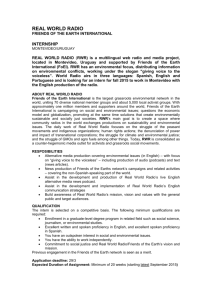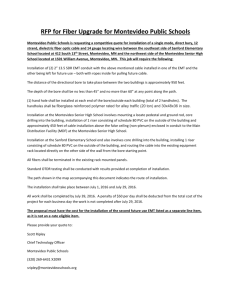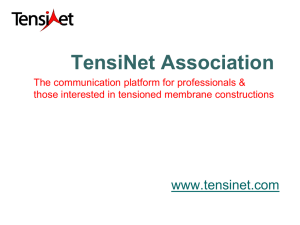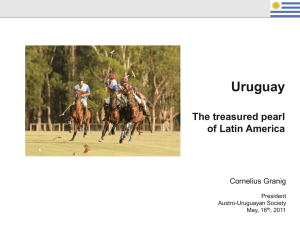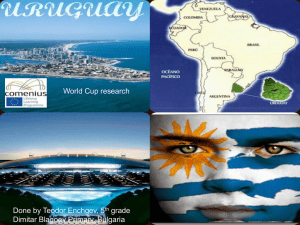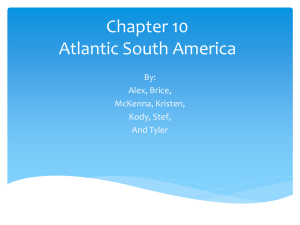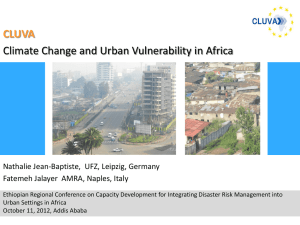2. Day 3. Session 40 GabriellaFeollaMontevideo
advertisement
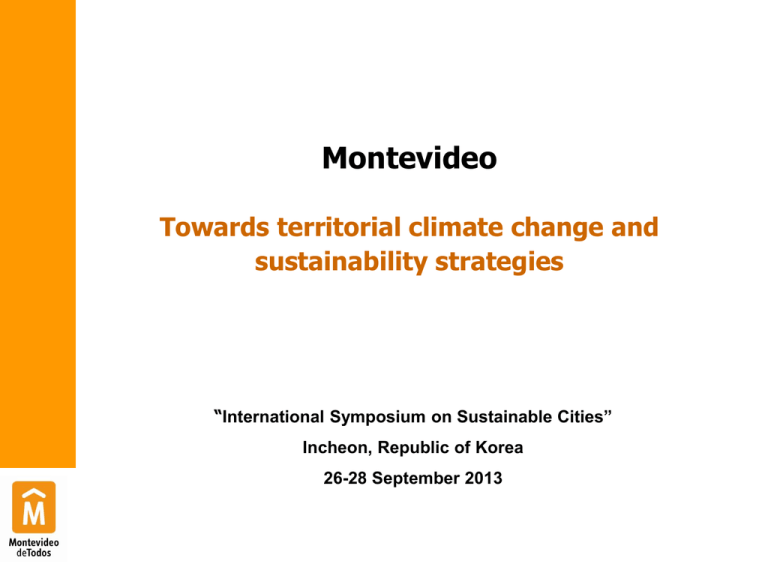
Montevideo Towards territorial climate change and sustainability strategies “International Symposium on Sustainable Cities” Incheon, Republic of Korea 26-28 September 2013 Montevideo (Uruguay) Area: Uruguay 176.215 Km2 Montevideo 530 Km2 (0.3% of total area) Population: Uruguay 3.163.700 inhab. Montevideo 1.344.800 inhab. (43% of the national population) Altitude and geography: maximum 134 m and 30 km of urban coast High vulnerability to Climate Change • Informal settlements in risk areas. • Vulnerable population affected by extreme events. • Coastal vulnerability (sea level rise, extreme events, saltwater intrusion). Infrastructure damages and sand-beach erosion, heavy storms. • Water resource vulnerability. • Increasing social fragmentation and concentration of high vulnerability agriculture producers in peripheral rural areas. • Vulnerability in food security. • Wetlands and other ecosystems with high vulnerability. • GHG emissions profile different from country (70% of Uruguay’s CO2 emissions) Participation in the Territorial Approach to Climate Change Initiative (TACC Uruguay) Territorial scope: Metropolitan Region Departments of Canelones, Montevideo and San José 1st project of the UNDP - UNEP global initiative called “Towards Carbon Neutral and Climate Change Resilient Territories”. Project Period: 2009 - 2012 The Metropolitan Climate Action Plan is the first experience of climate change planning at the subnational level in Uruguay. The Plan synthesizes a 3-years process of participatory planning with experts, citizens and local stakeholders. • Participatory process • Multi-disciplinary and inter-sectoral • Territorial approach • Capacity building The methodological approach used addresses climate change as a sustainable development issue. METROPOLITAN CLIMATE ACTION PLAN OF URUGUAY The Plan was developed in 5 steps The Metropolitan Plan was published in November 2012. http://www.montevideo.gub.uy/ciudadania/desarrolloambiental/documentos Metropolitan Climate Action Participatory planning Inter –institutional involvement + 30 workshops + 700 participants 2. Preparation of Climate Change Profiles & Scenarios Local GHG Emission Inventory Downscaled 10 IPCC Models at SRES A2 and B1 present, 2046-2065 and 20812100 3. Identification of Mitigation & Adaptation Options. + 500 identified actions 80 actions 25 strategies 6 development sectors Montevideo Working Group Impact maps as a tool for identification of strategic guidelines & projects. 4. Prioritizing actions and climate financing needs 5. Prepare comprehensive low-carbon & climate change resilient roadmap Montevideo Climate Plan & Metropolitan Climate Plan Example of strategies applied to Built Environment & Health Sector HS1 Sustainable management of the urban hidrologic cycle. HS2 Sustainable sanitation system for prevention of waterborne diseases. HS3 Community strategies for risk management. HS4 Reduction of GHG emissions from waste management. HS5 Reduction of residential and commercial GHG emissions. HS6 Increased control of vector borne diseases. HS7 Reduction of human health threats due to temperature variability. HS8 Local capacity- building in human health care. Montevideo Sustainable Program Participation in the Emerging and Sustainable Cities Initiative (IADB) Rapid assessment of Montevideo ENVIRONMENTAL SUSTAINABILITY & CLIMATE CHANGE URBAN SUSTAINABILITY WATER LAND USE SANITATION URBAN INEQUALITY SOLID WASTES ENERGY AIR QUALITY GREENHOUSE GASES FISCAL SUSTAINABILITY & GOVERNANCE PARTICIPATORY MANAGEMENT TRANSPORTATION MODERN PUBLIC MANAGEMENT COMPETITIVENESS TRANSPARENCY EMPLOYMENT TAX AND FINANCIAL AUTONOMY CONNECTIVITY NOISE EDUCATION VULNERABILITY TO NATURAL DISASTERS SECURITY HEALTH EXPENDITURE MANAGEMENT DEBT Montevideo Sustainable Program Emerging and Sustainable Cities Initiative Floods and Climate Change Priority areas for intervention Montevideo Sustainable Program Emerging and Sustainable Cities Initiative Poverty and informal settlements (slums) Solid Wastes Coverage Rapid territorial assessment Main Challenges in Montevideo Indicators in critical areas of Montevideo URBAN INEQUALIITY URBAN INEQUALITY SECURITY SECURITY SOLID WASTES SOLID WASTES TRANSPORTATION TRANSPORTATION EDUCATION EDUCATION EMPLOYMENT EMPLOYMENT WATER AND WATER AND SANITATION SANITATION “City within a City”: critical social areas with high infraestructure deficiencies, socio-spatial fragmentation and poverty. Montevideo Sustainable Program Emerging and Sustainable Cities Initiative (IADB) Identifying solutions: Integrated actions Example: Casavalle (VIDEO) Building a sustainable Montevideo Multidisciplinary Integrated Strategic Actions with a Territorial Approach Thank you for your attention! GABRIELLA FEOLA Director Environmental Quality and Control Services Government of Montevideo gabriella.feola@imm.gub.uy
